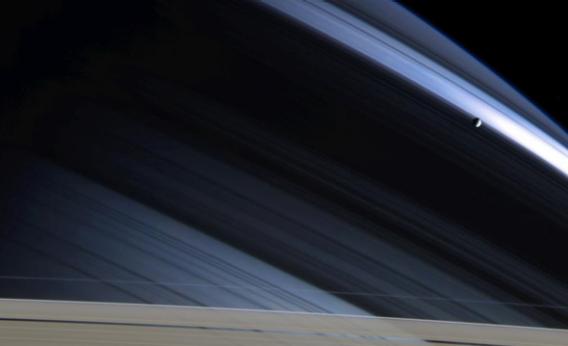Create a free profile to get unlimited access to exclusive videos, sweepstakes, and more!
Blue Skies Smiling on … Saturn?

The above picture of Saturn, like so many from the Cassini spacecraft, is heart-stoppingly beautiful. It shows the moon Mimas—which gets a lot of press on May the 4th every year—against the background of Saturn’s cloudtops, the rings seen in shades of tan and gray at the picture’s bottom. The planet’s disk is striated with ring shadows, the black lines of blocked sunlight intertwined with blue streaks of illuminated planet.
When I saw this image (taken way back in 2004) I assumed it was infrared, the colors depicted assigned to invisible wavelengths, making the planet look blue.
But file this under Stuff I Learned This Week: This is a natural color image, meant to closely mimic what we see with our eyes. That means Saturn really is blue!
Well, part of it, at least. I’m used to seeing Saturn as yellow, both through my own ‘scope as well as in pictures. And in fact, the southern hemisphere is yellow, but recently the northern hemisphere has appeared bluish. Why?
The atmosphere of Saturn is mostly hydrogen, but there are other molecules at the cloudtops. These contaminants, if you will, are what make Saturn look yellowish. But for some reason, in the north, these clouds have either dissipated or sunk, leaving clear hydrogen air behind.
Hydrogen molecules scatter light; it’s a bit like how throwing baseballs at a large rock will send the balls rebounding in all directions. However, the amount of scattering depends on the wavelength (the color) of the light. Blue light (with a short wavelength) is scattered far more than red (with a wavelength roughly twice as long).
We see this on Earth! White sunlight (which is combination of red, orange, yellow, green, blue, and violet photons) goes through our air, and nitrogen molecules scatter it. Blue light hits a nitrogen molecule and goes careening off in a new direction, while red tends to go right through. The effect is so strong, really, that even green, yellow, and orange light pretty much pass uncontested. That blue light goes off in some random direction; some goes up, away from Earth, and some goes down to the ground. But to someone standing on the ground it appears to come from some other direction than from the Sun. That’s why the sky looks blue!
The same is true for Saturn. Some of the incoming blue photons get scattered sideways, or down, but some go out, into space. From Cassini’s viewpoint, far above the planet, the atmosphere looks blue!
So why doesn’t the southern hemisphere look blue too? Well, the planet was in southern summer for a long time, but now its orbit and tilt have brought summer to the northern hemisphere. Maybe this is some phenomenon related to that change of season (like the ridiculously gigantic storm that blossomed in Saturn's northern hemisphere in 2010).
Either way, Saturn now joins the list of planets sporting a happy blue hue: Earth, Uranus, and Neptune. In the case of Uranus, its atmosphere contains methane, which is very good at absorbing red light. Sunlight penetrating its air gets all the red absorbed away, so what’s left to reflect back to us looks blue-green (this is the same reason water on Earth appears blue).
Neptune, though, is a deep blue, quite obvious even through a small telescope. It has methane in its air as well, but also must have an as-yet still unidentified molecule in its atmosphere that changes it from Uranus’s teal to a deep, azure blue. The two planets have very different atmospheres in other ways; Neptune is stormy while Uranus is calm (or keeps its storms discretely hidden below its cloud decks), for example. Interestingly, Neptune and Uranus both have about the same temperature at the tops of their clouds, even though Neptune is much farther from the Sun It must generate more internal heat than its sister planet.
So, in our solar system, it’s easy being blue. There are plenty of ways to do it, and those methods are exploited to various degrees by the various worlds. This makes me happy, and not just because blue is a lovely color. I like it because it shows that nature has many ways of displaying itself, and each is a key, a clue, to how it works. If every planet were the same, and we understood them all, what a boring Universe that would be.
I like the way things are now: beautiful, colorful, mysterious, and diverse. That’s a far more interesting place to live.


























